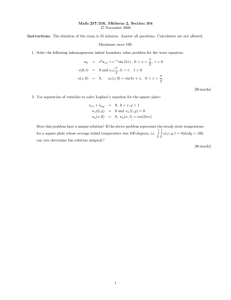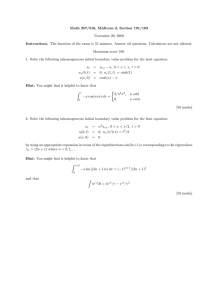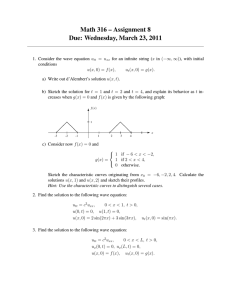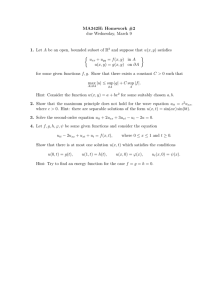List of Formulas (and Theorems) in Math400 I. First Order Equations b c
advertisement
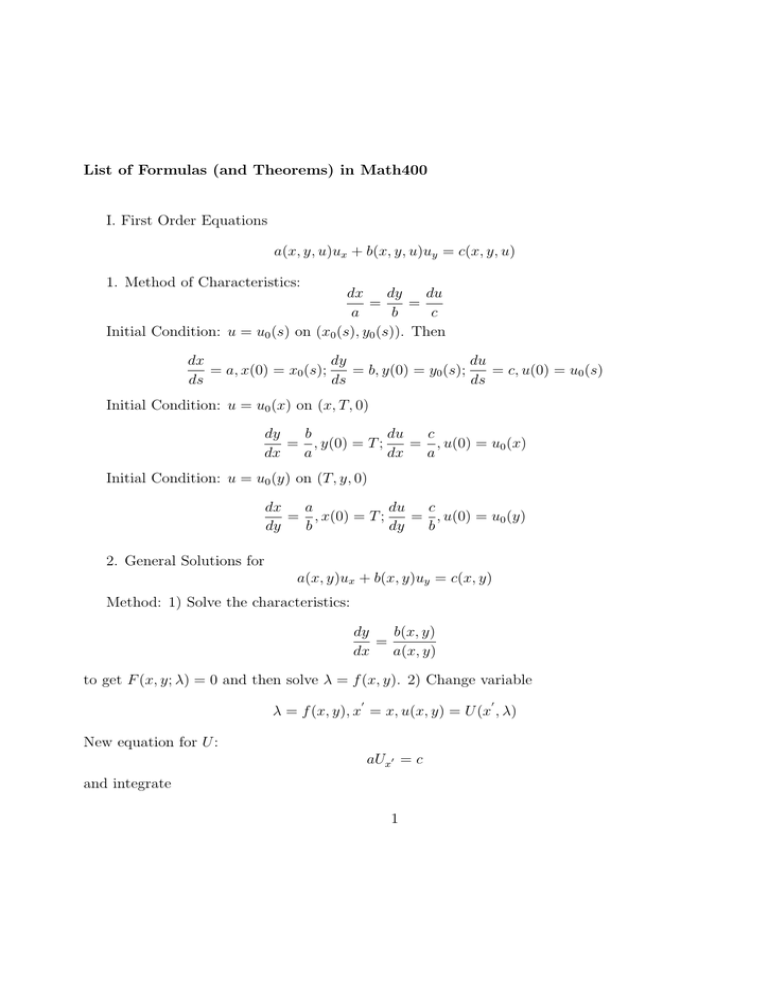
List of Formulas (and Theorems) in Math400 I. First Order Equations a(x, y, u)ux + b(x, y, u)uy = c(x, y, u) 1. Method of Characteristics: dx dy du = = a b c Initial Condition: u = u0 (s) on (x0 (s), y0 (s)). Then dy du dx = a, x(0) = x0 (s); = b, y(0) = y0 (s); = c, u(0) = u0 (s) ds ds ds Initial Condition: u = u0 (x) on (x, T, 0) dy b du c = , y(0) = T ; = , u(0) = u0 (x) dx a dx a Initial Condition: u = u0 (y) on (T, y, 0) dx a du c = , x(0) = T ; = , u(0) = u0 (y) dy b dy b 2. General Solutions for a(x, y)ux + b(x, y)uy = c(x, y) Method: 1) Solve the characteristics: dy b(x, y) = dx a(x, y) to get F (x, y; λ) = 0 and then solve λ = f (x, y). 2) Change variable 0 0 λ = f (x, y), x = x, u(x, y) = U (x , λ) New equation for U : aUx0 = c and integrate 1 3. Traffic Flow Problem: ρt + c(ρ)ρx = 0, ρ(x, 0) = ρ0 (x) 0 where Q (ρ) = c(ρ). General solution: x − ξ = c(φ(ξ))t Shock: ds Q(ρ+ ) − Q(ρ− ) = , s(t0 ) = x0 dt ρ+ − ρ− Expanding fan: x u = H( ), where c(H(λ)) = λ t II. Second order equations 1. Classification of second order equations a11 uxx + 2a12 uxy + a22 uyy + b1 ux + b2 uy = 0 Determinant b2 − 4ac Change of variables to standard form 2. Wave Equation on the whole line: ( utt − c2 uxx = f (x, t), −∞ < x < +∞, u(x, 0) = φ(x), ut (x, 0) = ψ(x), −∞ < x < +∞ D’Alembert’s formula 1 1 Z x+ct 1 Z t Z x+c(t−s) u(x, t) = (φ(x − ct) + φ(x + ct)) + ψ(s)ds + ( f (y, s)dy)ds 2 2c x−ct 2c 0 x−c(t−s) The energy If f = 0, then c2 Z +∞ 2 1Z ∞ 2 u (x, t)dt + u (x, t)dx E(t) = 2 −∞ t 2 −∞ x dE =0 dt 2 (1) 3. Diffusion Equation on the whole line: ( ut − kuxx = f (x, t), −∞ < x < +∞, t > 0 u(x, 0) = φ(x), −∞ < x < +∞ (2) Solution formula u(x, t) = Z ∞ −∞ S(x − y, t)φ(y)dy + Z t Z +∞ 0 −∞ S(x − y, t − s)f (y, s)dyds 4. Wave Equation on the half line: 2 utt − c uxx = f (x, t), 0 < x < +∞, t > 0 u(x, 0) = φ, ut (x, 0) = ψ(x), 0 < x < +∞ u(0, t) = 0 (3) Method of Reflection: extend f, φ, ψ oddly to (−∞, +∞). There is a similar formula for Neumann boundary condition. Inhomogeneous BC: u(0, t) = h(t). Use V (x, t) = u(x, t) − xh(t). 5. Diffusion Equation on the half line: ut − kuxx = f (x, t), 0 < x < +∞, t > 0 u(x, 0) = φ, 0 < x < +∞ u(0, t) = 0 (4) Method ofR Extension: extend f and φ oddly.R Solution formula: R u(x, t) = 0∞ (S(x−y, t)−s(x+y, t)φ(y))dy + 0t 0∞ (S(x−y, t−s)−S(x+y, t−s))f (y, s)dyds 6. Laplace equation ∆u = f in D 1) Uniqueness: The solution to Dirichlet BC is unique; the solution to Neumann BC is unique, up to a constant; the solution to Robin BC is unique provided a ≥ 0, a 6≡ 0. 2) Method of Solving Laplace Equation: Method of Separation of Variations Step 1: Find the right separated functions. Plug into PDE and BC (homogeneous or natural BC). Distinguish EVP and ODE. Step 2: Solve (EVP) and (ODE) Step 3: Sum-up.Plug in the inhomogeneous BC. 3) Laplace equation in rectangle and cubes 3 7. Sturm-Liouville Eigenvalue Problem 0 (p(x)X) + λw(x)X = 0, 0 < x < l, 0 0 X (0) − h0 X(0) = 0, X (l) + h1 X(l) = 0 Green’s identity: Z l 0 1) 2) 3) 4) 0 0 0 0 0 0 [f (pg ) − g(pf ) ] = (pf g − pf g)|l0 all eigenvalues are real all eigenfunctions are simple λ1 > 0 if h0 > 0, h1 > 0 Different eigenfunctions are orthoonal with respect to the weight function w: Z l 0 w(x)Xn Xm dx = 0 5) eigenvalues are discrete and approach to infinity λ1 < λ2 < ... < λn < ..., λn → +∞ 8. Method of Separation of Variables for heat equation/wave equation 1) Diffusion equation with source: ut = kuxx + f (x, t), u(x, 0) = φ u(0, t) = h(t), u(l, t) = k(t) Expansion: u= ∞ X un (t) sin( n=1 f (x, t) = ∞ X nπ x) l fn (t) sin( n=1 φ(x) = ∞ X φn sin( n=1 nπ x) l nπ x) l Then we need to solve 0 un + kλn un = 2nπ (h(t) − (−1)n k(t)) + fn (t) l2 4 un (0) = φn 2) Wave equation with source: utt = c2 uxx + f (x, t), u(x, 0) = φ, ut (x, 0) = ψ u(0, t) = h(t), u(l, t) = k(t) Expansion: u= ∞ X un (t) sin( n=1 f (x, t) = ∞ X nπ x) l fn (t) sin( n=1 φ(x) = ∞ X φn sin( nπ x) l ψn sin( nπ x) l n=1 ψ(x) = ∞ X nπ x) l n=1 Then we need to solve 00 un + c2 λn un = 2nπ (h(t) − (−1)n k(t)) + fn (t) 2 l 0 un (0) = φn , un (0) = ψn 9. Method of Separation of Variables in the polar coordinate 1) solution to ∆u = 0, 0 ≤ r < a, 0 ≤ θ < 2π, u(a, φ) = h(φ) is given by u(r, θ) = a0 + n X rn (an cos(nθ) + bn sin(nθ)) n=1 where 1 Z 2π 1 Z 2π 1 Z 2π h(φ)dφ, an = n h(φ cos(nφ)dφ, bn = n h(φ sin(nφ)dφ, a0 = 2π 0 πa 0 πa 0 or Poisson’s formula a2 − r2 Z 2π h(φ) dφ u(r, θ) = 2 2 2π a + r − 2ar cos(θ − φ) 0 5 2) Consequences of Poisson formula 2.1) Mean Value Theorem: If ∆u = 0 then u(0) = 1 Z 2π u(a, φ)dφ 2π 0 2.2) Maximum Principle: If ∆u = 0 in D then maxD̄ u = max∂D u and equality holds if and only if u ≡ Constant 3) Laplace equation on wedges, annulus, exterior of disk 4) Diffusion equation in polar coordinate 1 1 ut = k(urr + ur + 2 uθθ ) r r Bessel function of order zero: Bessel function of order n: 1 00 J0 + J0 + J0 = 0 r 1 n2 00 Jn + Jn + Jn − 2 Jn = 0 r r Bessel function of order ν: 1 ν2 00 Jn + Jn + Jn − 2 Jn = 0 r r 6
